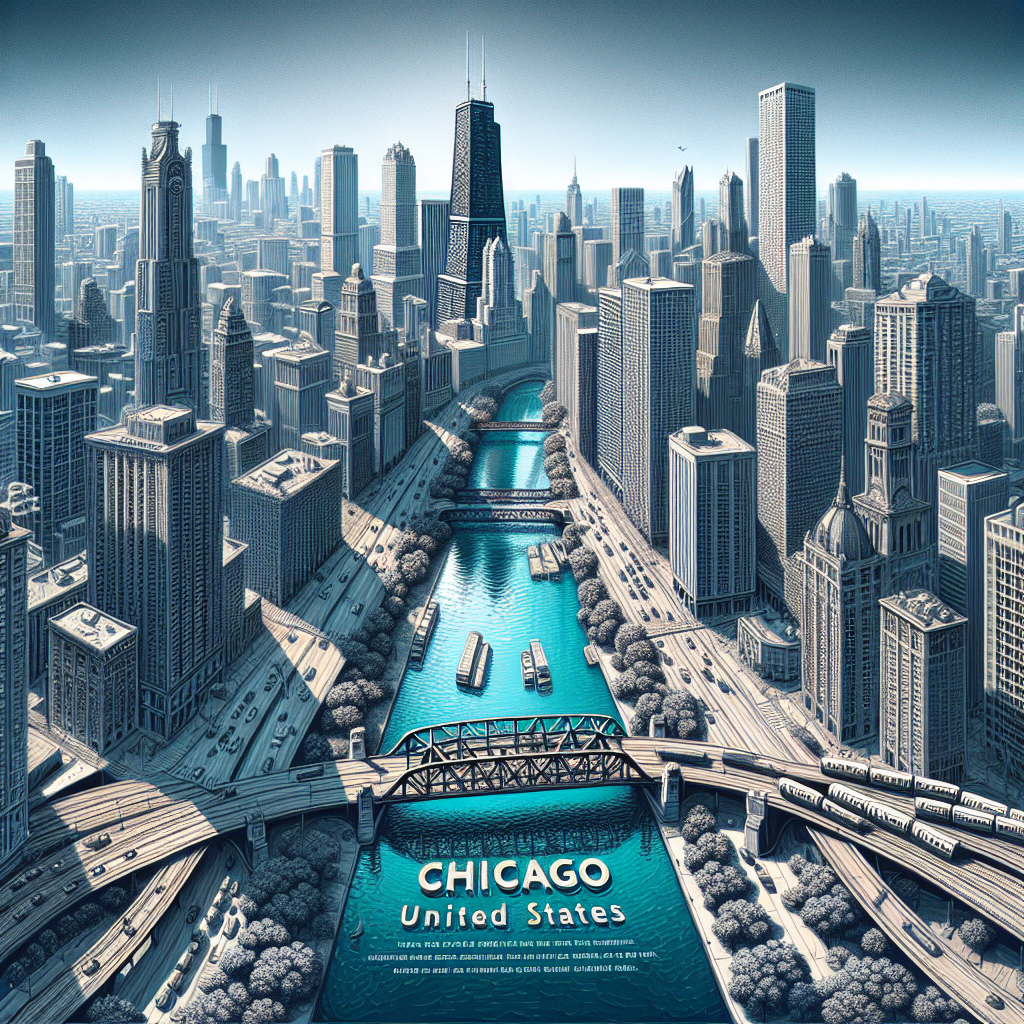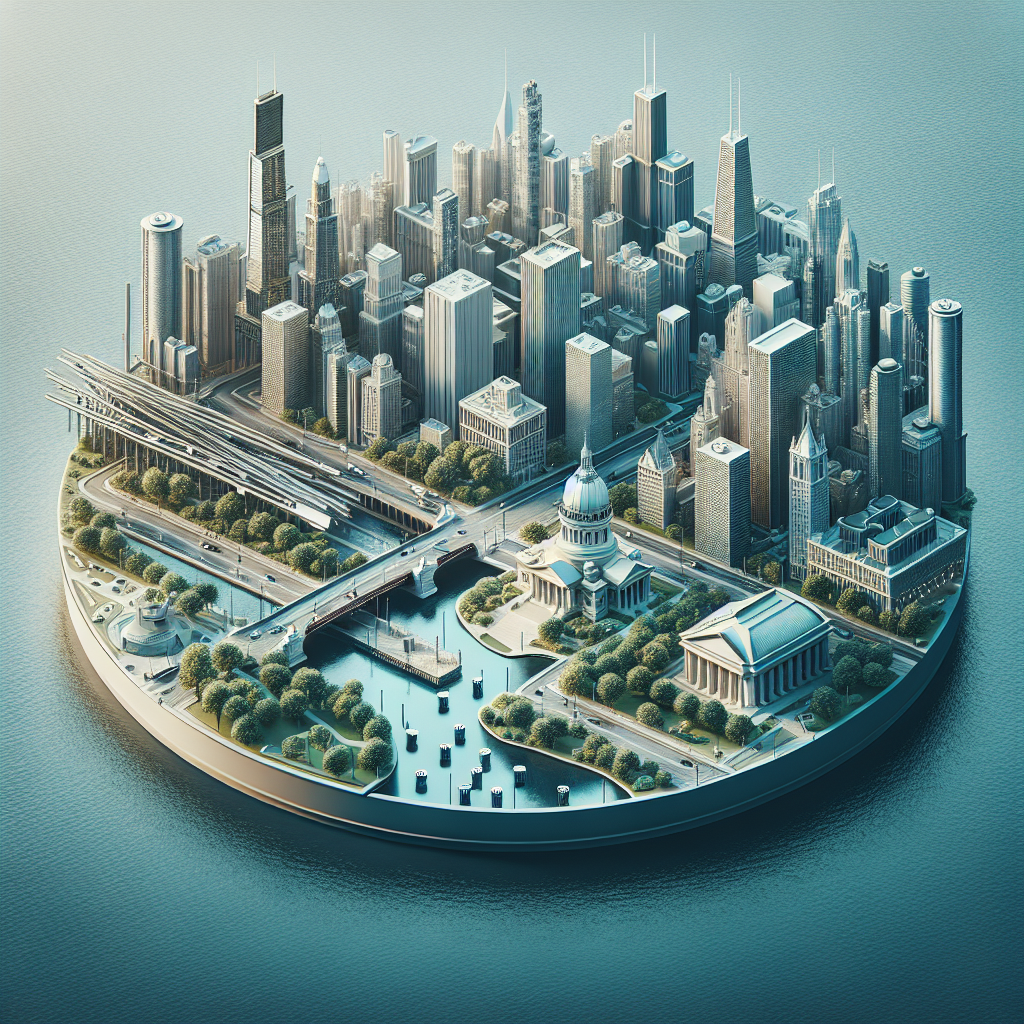Table of Content
TITLE: Why is Chicago so big?
COUNTRY CODE: US
LANGUAGE CODE: en
TABLE OF CONTENT:
- Introduction
- Historical Background
- Chicago’s Early Settlement
- The Great Chicago Fire
- Rebuilding and Growth
- Geographical Advantages
- Strategic Location
- Natural Resources
- Transportation Hub
- Economic Development
- Industrial Revolution Impact
- Emergence of Trade and Commerce
- Financial Sector Boom
- Cultural and Social Factors
- Immigration and Diversity
- Cultural Landmarks and Institutions
- Influence of Arts and Education
- Urban Planning and Infrastructure
- City Planning Initiatives
- Public Transportation Development
- Skyscrapers and Architectural Innovations
- Present-Day Chicago
- Population and Demographics
- Neighborhoods and Communities
- Modern Economy
- Key Takeaways
- Conclusion
Introduction
Chicago, known as the “Windy City,” isn’t just famous for its iconic skyline and deep-dish pizza. But have you ever wondered why Chicago is so big? The sprawling metropolis that we see today is the result of a fascinating interplay of historical, geographical, economic, and cultural factors.
From its early days as a trading post to becoming a bustling hub of commerce and culture, Chicago’s journey to prominence is nothing short of remarkable. Let’s embark on a journey to uncover the multifaceted reasons behind this city’s immense growth and influence.
Whether you’re curious about the city’s strategic location, its historical milestones like the Great Chicago Fire, or its vibrant cultural landscape, this exploration will provide a comprehensive understanding of what makes Chicago an urban giant.
For more insights into the city’s reputation, you might want to explore what people think about Chicago today.
Ready to delve into the details? Let’s get started!
Historical Background
Chicago’s remarkable evolution from a modest settlement to a sprawling urban center is deeply rooted in its historical background. Understanding the key events that shaped the city provides insight into its immense growth.
Chicago’s Early Settlement
Chicago’s origins trace back to the late 18th century when it was a humble trading post. The area’s strategic location by Lake Michigan made it an ideal spot for trading and settlement. Over time, it attracted more settlers, laying the groundwork for its future expansion.
The Great Chicago Fire
The Great Chicago Fire of 1871 was a pivotal moment in the city’s history. Although it devastated large parts of Chicago, the fire also sparked a massive rebuilding effort. This tragedy turned into an opportunity for urban planning and architectural innovation, setting the stage for the city’s rapid growth.
Rebuilding and Growth
In the aftermath of the fire, Chicago experienced a period of significant rebuilding and growth. The city’s leaders seized the moment to implement advanced urban planning techniques and construct new infrastructure. This era saw the rise of iconic buildings and the establishment of Chicago as a major urban center.
Curious about what makes Chicago so popular today? You might find this exploration of Chicago’s appeal insightful.
Next, let’s examine the geographical advantages that have played a crucial role in Chicago’s expansion.
Geographical Advantages
When you think of Chicago, it’s easy to picture its towering skyscrapers and bustling streets. But beneath its urban exterior lies a foundation built on geographical advantages that have significantly contributed to its growth.
Strategic Location
Perched on the southwestern shore of Lake Michigan, Chicago’s location is nothing short of strategic genius. The lake not only provided a vital waterway for early settlers and traders but also established the city as a critical junction for commerce. This advantageous position allowed Chicago to become a central hub for transportation and trade, connecting the East Coast with the Midwest and beyond. Curious about how locals pronounce Chicago? Take a look at the local dialect for a fun insight.
Natural Resources
Chicago’s growth was also fueled by the abundance of natural resources in the surrounding areas. The fertile land of the Midwest proved ideal for agriculture, turning the city into a vital agricultural and livestock trade center. Moreover, the proximity to coal mines and other raw materials facilitated industrial growth, attracting factories and businesses to the area.
Transportation Hub
Chicago’s role as a transportation hub cannot be overstated. The city is often referred to as the “Crossroads of America,” owing to its extensive network of railroads, highways, and airports. The establishment of the Illinois and Michigan Canal in the 19th century further cemented its status as a critical transportation nexus. Today, Chicago remains one of the busiest transportation centers in the United States, playing a pivotal role in the national and international movement of goods and people.
For a deeper dive into Chicago’s present-day safety and urban dynamics, you may find this article on current safety in downtown Chicago quite informative.
Next, we’ll explore how economic development has driven Chicago’s monumental growth.
Economic Development
Chicago’s rise to prominence isn’t just a tale of geographical luck and historical resilience. It’s also a story of relentless economic development that transformed it into an industrial and financial powerhouse. Each phase of economic growth has played a crucial role in shaping the city’s present-day stature.
Industrial Revolution Impact
The Industrial Revolution was a catalyst for Chicago’s rapid expansion. The city’s strategic location and abundant resources made it an ideal hub for manufacturing and industry. Factories sprang up, producing everything from steel to meat products, earning Chicago the nickname “The City of Broad Shoulders.” This industrial boom attracted a wave of workers, further fueling the city’s growth.
Emergence of Trade and Commerce
As industry flourished, so did trade and commerce. Chicago’s markets became vibrant centers of activity, with goods flowing in and out via its extensive transportation network. The Chicago Board of Trade, established in 1848, became one of the world’s leading futures and options trading exchanges, cementing the city’s reputation as a commercial giant.
Financial Sector Boom
With a burgeoning industrial and commercial landscape, it was only natural for Chicago to develop a robust financial sector. Banks, investment firms, and insurance companies set up shop, creating a dynamic financial ecosystem. The city’s financial district, known as “The Loop,” became a bustling hub of economic activity. Even today, Chicago remains a critical player in the global financial market, with institutions like the Federal Reserve Bank of Chicago and the Chicago Mercantile Exchange leading the way.
Curious about the ongoing debates on the safety and livability between major cities? Check out this comparative analysis on whether New York or Chicago is safer.
Next, let’s delve into the cultural and social factors that have enriched Chicago’s diverse and vibrant identity.
Cultural and Social Factors
Chicago’s growth isn’t only a story of industrial might and geographical fortune; it’s also a tale of rich cultural and social dynamics. The city’s diverse population, iconic landmarks, and vibrant arts scene have all contributed to making Chicago a cultural powerhouse.
Immigration and Diversity
Chicago has long been a melting pot of cultures. Waves of immigrants from Europe, Latin America, Asia, and Africa have settled in the city, each group bringing its own unique traditions, foods, and customs. This rich blend of cultures has shaped Chicago’s neighborhoods, from Pilsen’s vibrant Mexican-American community to the historic Chinatown. It’s this diversity that gives Chicago its unique character and global appeal.
Cultural Landmarks and Institutions
Chicago is home to a plethora of cultural landmarks and institutions that reflect its rich history and artistic heritage. The Art Institute of Chicago, one of the oldest and largest art museums in the country, boasts an impressive collection that spans centuries and continents. The city’s theater scene is equally vibrant, with renowned institutions like the Goodman Theatre and Steppenwolf Theatre Company. For a deeper dive into Chicago’s cultural significance, explore why it’s referred to as the “White City”.
Influence of Arts and Education
The influence of arts and education in Chicago cannot be overstated. The city is a hub for music, particularly jazz and blues, which have deep roots in the African American community. Institutions like the University of Chicago and Northwestern University contribute to the city’s intellectual and cultural life, fostering innovation and thought leadership. The Chicago Symphony Orchestra and Lyric Opera of Chicago are world-renowned, attracting audiences from across the globe.
Not sure if Chicago’s friendly vibe matches its bustling cityscape? Find out more about the city’s social atmosphere by exploring whether people in Chicago are friendly.
Next, we’ll explore how urban planning and infrastructure have played pivotal roles in Chicago’s development.
Urban Planning and Infrastructure
Chicago’s growth story is also one of visionary urban planning and robust infrastructure development. These elements have been instrumental in transforming the city into a well-organized and efficiently functioning metropolis.
City Planning Initiatives
Following the devastation of the Great Chicago Fire, city planners seized the opportunity to rethink Chicago’s layout. The result was a grid system that facilitated easy navigation and efficient land use. Daniel Burnham’s 1909 Plan of Chicago further envisioned expansive public spaces, broad boulevards, and improved sanitation systems. This forward-thinking approach to city planning has been a cornerstone of Chicago’s growth and functionality.
Public Transportation Development
Public transportation has been a crucial factor in Chicago’s expansion. The city boasts one of the largest and most comprehensive public transit systems in the United States. The Chicago Transit Authority (CTA) operates buses and an extensive network of “L” trains, connecting neighborhoods and facilitating easy commutes. This network not only supports daily commuting but also attracts tourists, contributing to the city’s economic vitality. For insights into the city’s safety, especially for commuters, check out the current state of downtown Chicago’s safety here.
Skyscrapers and Architectural Innovations
Chicago is often hailed as the birthplace of the skyscraper. The city’s skyline is a testament to its architectural innovation and ambition. From the historic Willis Tower (formerly Sears Tower) to the modernist Aqua Tower, these towering structures symbolize Chicago’s economic power and architectural prowess. The city’s skyline not only attracts tourists but also serves as a hub for businesses and residents, contributing to its reputation as a global city.
Curious about the friendly atmosphere in Chicago neighborhoods? You might find this discussion on Chicagoans’ friendliness enlightening.
Next, let’s explore the current state of Chicago, focusing on its population, neighborhoods, and modern economy.
Present-Day Chicago
Today, Chicago stands as a vibrant, dynamic city, a testament to its rich history, geographical advantages, and visionary urban planning. Let’s delve into the contemporary facets that shape this urban giant.
Population and Demographics
Chicago is home to a diverse population of nearly 2.7 million people, making it the third most populous city in the United States. This melting pot of cultures and ethnicities contributes to the city’s unique social fabric. From its rich African American heritage to the thriving Latino and Asian communities, Chicago’s demographic diversity is a key element of its identity.
Neighborhoods and Communities
The city is a mosaic of neighborhoods, each with its own distinct character and charm. From the historic architecture of Hyde Park to the vibrant nightlife of Wicker Park, Chicago’s neighborhoods offer a range of experiences. These communities are the lifeblood of the city, fostering a sense of belonging and local pride. For a deeper dive into what makes these neighborhoods tick, explore how you can tell someone is from Chicago.
Modern Economy
Chicago’s economy is as diverse as its population. The city is a major financial hub, home to the Chicago Mercantile Exchange and numerous Fortune 500 companies. It’s also a leader in sectors such as healthcare, education, and technology. The modern economy of Chicago continues to attract businesses and professionals, contributing to its status as a global city.
Interested in how Chicago compares to other cities? Check out this discussion on whether Chicago or Boston is better for a nuanced perspective.
Next, we’ll summarize the key takeaways from our exploration of Chicago’s growth and significance.
Key Takeaways
Chicago’s journey from a modest trading post to a sprawling urban giant is a testament to a multitude of factors working in harmony. The city’s remarkable growth can be attributed to its strategic geographical location, rich historical background, robust economic development, vibrant cultural scene, and visionary urban planning.
- Historical Resilience: From its early settlement to bouncing back stronger after the Great Chicago Fire, Chicago’s history is marked by resilience and innovation.
- Geographical Advantages: Its prime location by Lake Michigan and abundance of natural resources have made Chicago a pivotal hub for trade and transportation.
- Economic Powerhouse: The city’s industrial boom, thriving trade and commerce, and a dynamic financial sector have driven its economic growth.
- Cultural Diversity: A melting pot of cultures, Chicago’s diverse communities and rich cultural landmarks have enriched its social fabric.
- Urban Planning: Visionary city planning and infrastructure development, including its extensive public transportation network and iconic skyscrapers, have shaped Chicago into a modern metropolis.
As we reflect on what makes Chicago so big and influential, it’s clear that the city is a blend of history, geography, economy, culture, and planning. For those curious about Chicago’s local flavor, exploring its famous foods can offer a delicious perspective.
In conclusion, Chicago’s growth is not just a story of size but one of complexity, resilience, and innovation. Whether you’re a resident or a visitor, understanding these factors offers a deeper appreciation of the Windy City’s grandeur.
Conclusion
In the grand tapestry of American cities, Chicago stands out as a beacon of growth, resilience, and ingenuity. This urban giant’s journey from a modest trading post to a bustling metropolis is a narrative woven with threads of historical events, geographical blessings, economic milestones, cultural richness, and visionary planning.
Chicago’s strategic location by Lake Michigan laid the groundwork for its emergence as a critical transportation and trade hub. The city’s history, marked by resilience in the face of calamities like the Great Chicago Fire, showcases its ability to turn adversity into opportunity. Its economic evolution, fueled by the Industrial Revolution and the rise of trade and finance, positioned Chicago as a powerhouse on the global stage.
The cultural and social fabric of Chicago, enriched by waves of immigration and a vibrant arts scene, adds a unique dimension to its identity. From iconic landmarks to world-renowned institutions, the city’s cultural landscape is a testament to its diverse and dynamic spirit. Urban planning and infrastructure development, including the extensive public transportation network and architectural marvels, have further solidified Chicago’s status as a modern and efficient metropolis.
As we reflect on the factors that have contributed to Chicago’s immense growth, it’s clear that the city is a harmonious blend of history, geography, economy, culture, and innovation. Whether you’re interested in its historical milestones, geographical advantages, economic prowess, cultural landmarks, or urban planning achievements, Chicago offers a wealth of insights and experiences.
For a deeper understanding of what makes Chicago special and to explore more about its vibrant present, you might want to delve into how you can tell someone is from Chicago. And don’t miss out on the local flavor by discovering what food Chicago is known for.
In conclusion, Chicago’s growth is a multifaceted tale of size, complexity, resilience, and innovation. Whether you’re a resident, a visitor, or just curious about this remarkable city, understanding these factors offers a deeper appreciation of the Windy City’s grandeur and significance.




